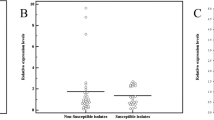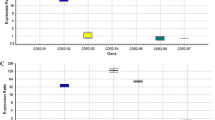Abstract
Azole resistance in the pathogenic yeast Candida albicans poses significant challenges for its antibiotic treatment. The conformational change of the target enzyme 14 alpha-demethylase (Erg11p) due to ERG11 gene mutations is one of the mechanisms resulting in the azole resistance. ERG11 of 23 isolates (8 susceptible and 15 resistant) and 6 standard strains of Candida albicans were amplified and sequenced. Nineteen missense mutations were detected. Two mutations, G487T (A114S) and T916C (Y257H), coexisted exclusively in 14 fluconazole-resistant isolates. To identify the resistance mechanisms in the isolates with G487T and T916C mutations, we compared the expression of 5 resistance-related genes in the 14 azole-resistant isolates with those in the susceptible type strain ATCC 10231, Saccharomyces cerevisiae AD/CDR1 and AD/CDR2. The tested values of mRNA transcription of CDR1 and CDR2 were higher than that of control strain, while the semi-quantified Cdr1p values were not higher in all of the 14 resistant isolates. And the data analyzed with t test suggest that both of the differences are significant (P < 0.0005) when the resistant isolates are considered as a whole. Cdr2p was up-regulated in 5 isolates, and down-regulated or even undetectable in the remaining 9 isolates. The transcription of ERG11, MDR1, and FLU1 varied in these isolates. These data suggested that overexpression of the five genes might not be the reason of resistance in the 14 isolates with G487T and T916C, especially in the 5 isolates (GZ09, GZ15, GZ16, GZ58, and 4263) in which neither translation of Cdr1p/Cdr2p nor transcription of ERG11, MDR1, or FLU1 was detected up-regulated. The results suggest that Erg11p conformational change due to the point mutations is most likely responsible for the azole resistance in these isolates.
Similar content being viewed by others
References
Clinical and Laboratory Standards Institute (2008) M27-A3. Reference method for broth dilution antifungal susceptibility testing of yeasts, 3rd ed. Clinical and Laboratory Standards Institute, Wayne, PA
Cowen LE, Sanglard D, Calabrese D, Sirjusingh C, Anderson JB, Kohn LM (2000) Evolution of drug resistance in experimental populations of Candida albicans. J Bacteriol 182:1515–1522
Ge SH, Wan Z, Li J, Xu J, Li RY, Bai FY (2010) Correlation between azole susceptibilities, genotypes, and ERG11 mutations in Candida albicans isolates associated with vulvovaginal candidiasis in China. Antimicrob Agents Chemother 54:3126–3131
Goldman GH, da Silva Ferreira ME, dos Reis Marques E, Savoldi M, Perlin D, Park S, Godoy Martinez PC, Goldman MH, Colombo AL (2004) Evaluation of fluconazole resistance mechanisms in Candida albicans clinical isolates from HIV-infected patients in Brazil. Diagn Microbiol Infect Dis 50:25–32
Holmes AR, Lin YH, Niimi K, Lamping E, Keniya M, Niimi M, Tanabe K, Monk BC, Cannon RD (2008) ABC transporter Cdr1p contributes more than Cdr2p does to fluconazole efflux in fluconazole-resistant Candida albicans clinical Isolates. Antimicrob Agents Chemother 52:3851–3862
Ji H, Zhang W, Zhou Y, Zhang M et al (2000) A three-dimensional model of lanosterol 14alpha-demethylase of Candida albicans and its interaction with azole antifungals. J Med Chem 43:2493–2505
Jiang WS, Tan SS, Jiang GY, Chen QX (2006) Synergistic effect of terbinafine combined with fluconazole or itroconazole on stable fluconazole-resistant Candida albicans induced by fluconazole in vitro. Chin J Microbiol Immunol 26:360–364
Kakeya H, Miyazaki Y, Miyazaki H, Nyswaner K, Grimberg B, Bennett JE (2000) Genetic analysis of azole resistance in the Darlington strain of Candida albicans. Antimicrob Agents Chemother 44:2985–2990
Krcmery V, Barnes AJ (2002) Non-albicans Candida spp. causing fungaemia: pathogenicity and antifungal resistance. J Hosp Infect 50:243–260
Lamb DC, Kelly DE, Schunck WH, Shyadehi AZ, Akhtar M, Lowe DJ, Baldwin BC, Kelly SL (1997) The mutation T315A in Candida albicans sterol 14α-demethylase causes reduced enzyme activity and fluconazole-resistance through reduced affinity. J Biol Chem 272:5682–5688
Lamb DC, Kelly DE, White TC, Kelly SL (2000) The R467K amino acid substitution in Candida albicans sterol 14alpha-demethylase causes drug resistance through reduced affinity. Antimicrob Agents Chemother 44:63–67
Livak KJ, Schmittgen TD (2001) Analysis of relative gene expression data using real-time quantitative PCR and the 2(-Delta Delta C(T)) method. Methods 25:402–408
Long F, Zhang YX, Lan HK, Wang YY, Zhu DM, Ren DM (2002) The point mutation of cytochrome P-450 lanosterol 14-α demethylase ERG11 gene in Fluconazole-resistant Candida albicans. Chin J Infect Dis 20:211–214
Maebashi K, Kudoh M, Nishiyama Y, Makimura K, Uchida K, Mori T, Yamaguchi H (2002) A novel mechanism of fluconazole-resistance associated with fluconazole sequestration in Candida albicans isolates from a myelofibrosis patient. Microbiol Immunol 46:317–326
Marichal P, Koymans L, Willemsens S et al (1999) Contribution of mutations in the cytochrome P450 14 alpha-demethylase (Erg11p, Cyp51p) to azole resistance in Candida albicans. Microbiology 145:2701–2713
Marr KA, Lyons CN, Rustad TR, Bowden RA, White TC (1998) Rapid, transient fluconazole-resistance in Candida albicans is associated with increased mRNA levels of CDR. Antimicrob Agents Chemother 42:2584–2589
Martel CM, Parker JE, Bader O, Weig M, Gross U, Warrilow AG, Kelly DE, Kelly SL(2010) A clinical isolate of Candida albicans with mutations in ERG11 (encoding sterol 14alpha-demethylase) and ERG5 (encoding C22 desaturase) is cross resistant to azoles and amphotericin B. Antimicrob Agents Chemother 54:3578–3583. Published online 2010 Jun 14. doi:10.1128/AAC.00303-10
Micheli M, Bille J, Schueller C, Sanglard D (2002) A common drug-responsive element mediates the upregulation of the Candida albicans ABC transporters CDR1and CDR2, two genes involved in antifungal drug resistance. Mol Microbiol 43:1197–1214
Monk BC, Tomasiak TM, Keniya MV, Huschmann FU et al (2014) Architecture of a single membrane spanning cytochrome P450 suggests constraints that orient the catalytic domain relative to a bilayer. Proc Natl Acad Sci USA 111:3865–3870
Park S, Perlin DS (2005) Establishing surrogate markers for fluconazole-resistance in Candida albicans. Microb Drug Resist 11:232–238
Pemán J, Cantón E, Miñana JJ et al (2011) Changes in the epidemiology of fungaemia and fluconazole susceptibility of blood isolates during the last 10 years in Spain: results from the FUNGEMYCA study. Rev Iberoam Micol 28:91–99
Perea S, López-Ribot JL, Kirkpatrick WR, McAtee RK, Santillán RA, Martínez M, Calabrese D, Sanglard D, Patterson TF (2001) Prevalence of molecular mechanisms of resistance to azole antifungal agents in Candida albicans strains displaying high-level fluconazole-resistance isolated from human immunodeficiency virus-infected patients. Antimicrob Agents Chemother 45:2676–2684
Podust LM, Poulos TL, Waterman MR (2001) Crystal structure of cytochrome P450 14α-sterol demethylase (CYP51) from Mycobacterium tuberculosis in complex with azole inhibitors. Proc Natl Acad Sci USA 98:3068–3073
Sanglard D, Ischer F, Koymans L, Bille J (1998) Amino acid substitutions in the cytochrome P-450 lanosterol 14alpha-demethylase (CYP51A1) from azole-resistant Candida albicans clinical isolates contribute to resistance to azole antifungal agents. Antimicrob Agents Chemother 42:241–253
Spiliopoulou A, Vamvakopoulou S, Bartzavali C, Dimitracopoulos G, Anastassiou ED, Christofidou M (2010) Eleven-year retrospective survey of candidaemia in a university hospital in southwestern Greece. Clin Microbiol Infect 16:1378–1381
White TC (1997) The presence of an R467 K amino acid substitution and loss of allelic variation correlate with an azole-resistant lanosterol 14alpha demethylase in Candida albicans. Antimicrob Agents Chemother 41:1488–1494
White TC, Holleman S, Dy F, Mirels LF, Stevens DA (2002) Resistance mechanisms in clinical isolates of Candida albicans. Antimicrob Agents Chemother 46:1704–1713
Xu Y, Chen L, Li C (2008) Susceptibility of clinical isolates of Candida species to fluconazole and detection of Candida albicans ERG11 mutations. J Antimicrob Chemother 61:798–804
Acknowledgments
This study was funded by the National Science Foundation of China (No. 30901294), the Shandong Provincial Science and Technology Project Fundation (No. 2009GG2NC02004), and the Shandong Provincial Natural Science Foundation, China (No. ZR2011HQ005). We thank Prof. John E. Bennett (National Institutes of Health, USA), Prof. Ann R. Holmes (Otago University, New Zealand), Prof. Liyan Xi (Sun Yat-sen University, China), Prof. Ruoyu Li (Peking University, China), Prof. Yongnian Shen (Chinese Cultural Collection Commission for Microbiology, China) for their kindly supply of isolates, or type strains, and Prof. Dominique Sanglard (University of Lausanne, Switzerland) for his anti-Cdr1p antibody as a gift.
Author information
Authors and Affiliations
Corresponding author
Ethics declarations
Conflict of interest
The authors declare that they have no conflict of interest.
Additional information
Communicated by Erko Stackebrandt.
Rights and permissions
About this article
Cite this article
Xu, Y., Sheng, F., Zhao, J. et al. ERG11 mutations and expression of resistance genes in fluconazole-resistant Candida albicans isolates. Arch Microbiol 197, 1087–1093 (2015). https://doi.org/10.1007/s00203-015-1146-8
Received:
Revised:
Accepted:
Published:
Issue Date:
DOI: https://doi.org/10.1007/s00203-015-1146-8




